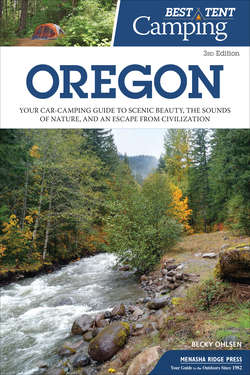Читать книгу Best Tent Camping: Oregon - Becky Ohlsen - Страница 9
На сайте Литреса книга снята с продажи.
ОглавлениеPREFACE
Looking back, most of us can probably summon up a formative tent-camping experience—something that defined for us early on what it means to go camping. Mine involved rain. A lot of rain. I was about 10 years old, and my dad had decided to take my brother and me away for a weekend camping trip in the woods. Mom stayed behind for some much-anticipated peace and quiet. The trip did not go quite as planned. Turns out, when you come back to camp at the end of a long cold day of fishing and hiking to find that the miserable downpour has left you, your camping gear, and both of your children thoroughly, irreparably drenched, the only sound decision is to pack everybody back into the van and drive home. (Needless to say, this was not quite the way my mom had hoped the trip would go either. She had just settled in with a cup of tea and a good book when our soggy crew trudged in two days ahead of schedule, dripping, whining, and offering up our wet sleeping bags for her to deal with.)
In retrospect, it was lucky I went on that trip, however abbreviated it was. The early association between camping and rain prepared me well for years of pitching tents in Oregon, where, even in mid-July, it’s seldom a good idea to leave off the rainfly.
Like it or not, rain is a defining characteristic of camping across Oregon for much of the year. Mind you, it’s not as bad as people say: August is pretty reliably warm and dry. Of course, that brings the threat of wildfires, which seem to tear through different parts of the state every year. It’s all part of the cycle, and camping here means resigning yourself to whatever diabolical—or, if you’re lucky, delightful—plans nature has in mind.
But in exchange for a bit of dramatic weather, Oregon gets velvety glacial valleys, thick old-growth forests, glimmering lakes, thunderous waterfalls, roaring rivers, snowcapped peaks, stunning hillsides full of spring wildflowers, lush rainforests where moss-draped trees shake hands across creekbeds, magical deserts, a vivid green coastline, and just about everything in between—not to mention all the wild creatures that live in each of these habitats.
As anyone who’s spent any time traveling here knows, Oregon is a place of unparalleled beauty and diversity. Extremes of climate, terrain, and vegetation can be experienced in a single day’s outing. In a few hours, you can drive from the Blue Mountains to Hells Canyon and feel like you’ve gone interstellar. The southeast corner of the state could not be more different from the southwest: arid, expansive, and dotted with mustangs on the one hand; lush, green, and stormy on the other. The campgrounds included in this book offer a sample of the variety that makes Oregon such a prized destination for those who seek outstanding outdoor adventures. But keep in mind that it’s only a sample; there are plenty of unexplored corners of the state, hidden places that might be right around the corner from some of the places we describe here. As you use this book, be sure to supplement it with your own sense of adventure and discovery. As for things to do once you reach your chosen campground, we provide some leads here, but there’s bound to be more than we can pack into one book. Explore as much as you have time for—you won’t regret it.
If you’re the sort who values solitude and serenity above all else, you may have to seek adventure farther afield than most other people. (That is, unless you’re up for some backcountry camping—there are loads of great backpacking options within an easy drive of Portland.) Oregonians and our neighbors are active users of the great outdoors; car camping is popular here, and the best-known sites are bound to be crowded, especially in summer. (Blame the rain, if you like.) To escape the crowds, you’ll need to drive farther, climb higher, and plan more creatively—or be more spontaneous. Why not see what’s at the end of that mysterious dirt road? Be aware that it takes a good chunk of time to reach some of the more interesting and far-flung corners of the state, but it’s well worth the effort. Our advice: Load up the car, settle in for a long drive, and enjoy the journey as much as the destination.
REGIONS IN THIS BOOK
Oregon contains an astounding variety of terrain, from rainforest to high desert and just about everything in between. Probably the most obvious distinction is the one separating the western and eastern parts of the state, in climate, terrain, and even lifestyle. The rugged coast and the Cascade Mountains, which run north–south through the state, are generally considered western Oregon, while eastern Oregon (larger and sparsely populated) includes vast stretches of arid land. For ease in planning your trip, we have further grouped campgrounds into six regions, dividing those along the coast into northern and southern groups; dividing those in the Cascades into northern, central, and southern groups; and presenting the scattered offerings of eastern Oregon in a single group.
photographed by Musgrove and the Pumi
The North Fork of the Malheur River provides a scenic backdrop to its eponymous campground.
